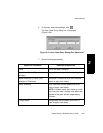
Chapter 3 Peak Detection and Labeling
3-68 Applied Biosystems
3
• For spectral data, determines the peak boundaries by
one of two means:
• If the Noise Threshold is greater than zero, the
software scans from the valley regions toward the
apex region using the number of data points
defined by the Filter Width. If the difference
between two consecutive filtered regions is
greater than the Noise Threshold, the midpoint of
the filter region closest to the apex is used as the
peak bound.
• If the Noise Threshold is zero, the software scans
the valley regions for the minimum points to
determine the peak bounds.
For chromatogram data, determines the peak boundaries
by:
• Determining the Noise Threshold by performing an
automatic signal-to-noise calculation on the tallest
peak in the chromatogram and using 75 percent of
the noise value determined as the threshold.
• Scanning from the valley regions toward the apex
region using the number of data points defined by
the Filter Width. If the difference between two
consecutive filtered regions is greater than the
Noise Threshold, the midpoint of the filter region
closest to the apex is used as the peak bound.
• Compares the area of the new peak to the %Max Peak
Area and the Minimum Area. A Minimum Area of 2 is
used for chromatogram data. If the new peak is within the
specified area settings, the peak is added to the peak list.


















